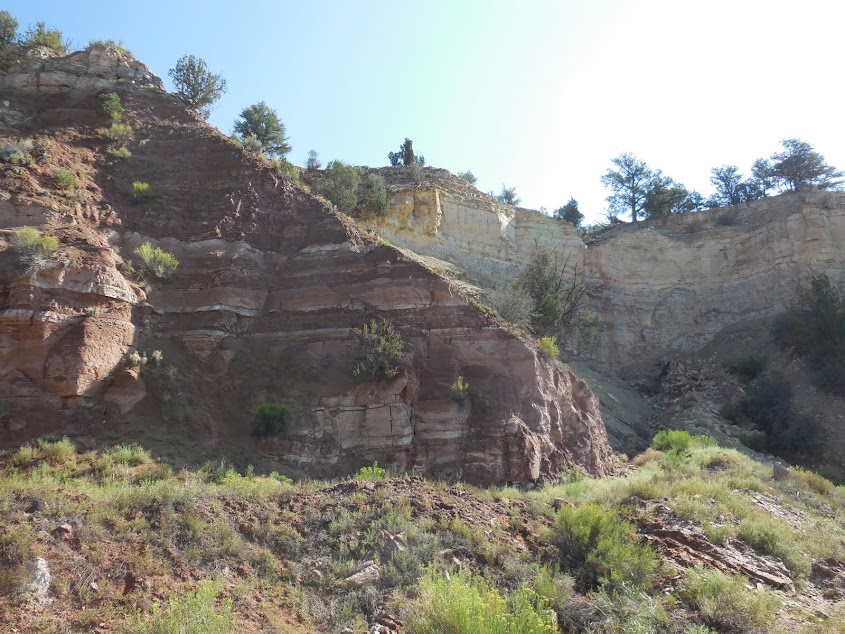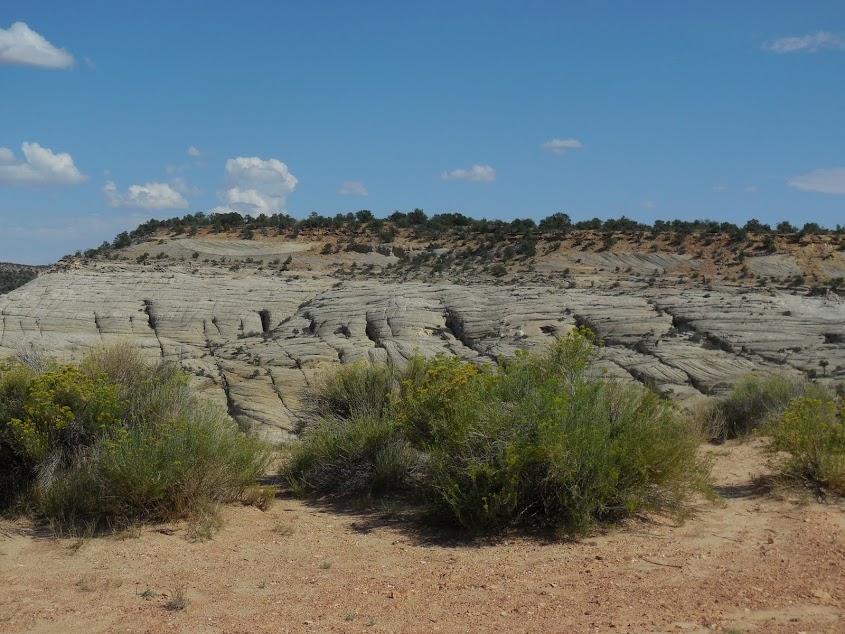Today is my birthday, although it doesn't feel much like a birthday--no presents, no cake, no ice cream.
It was also a fairly busy week, culminating in another field trip. Yay for field trips! This trip was for my groundwater class. Groundwater so far has turned out to be my most boring class--not because groundwater itself is boring, but because we have mostly done math and uninteresting labs. On our way to our field trip, someone asked jokingly why we didn't do this trip earlier in the semester (since it was so cold), and someone said it was because we didn't know anything about groundwater then. Then someone said that we still don't know anything about groundwater. (That comforted me, since I felt like I was the only one.)
But I'm getting ahead of myself.
On Friday, I had to miss my 3:00 writing class because we were leaving at 3:00. There were twenty of us students, two grad students, and our professor. We all loaded up in two geology vans and a truck and headed out to Great Basin National Park. This was just barely the seventh national park I went to at the age of 24, the others being Death Valley in November for Geomorphology, Kings Canyon and Sequoia in June with my family, and Zion, Bryce Canyon, and Capitol Reef for Geology 210.
Lots of people brought iPods, but I was the only one who brought a cord to plug them into the stereo. If I had known the kind of stuff we were going to listen to, I wouldn't have brought it. I was surprised that my fellow BYU students were listening to music and standup comedy with such utterly foul language. Sometimes I think my Lady Gaga is pushing the limits, but I had to listen to Gaga on my headphones in order to try to block out all the offensive stuff! I guess I could have asked them not to play that kind of stuff (after all, the only reason they were able to was because I brought the cord), but I feared man more than I feared God and didn't say anything. I think the next time I go on a trip like that (if I go on one again), I will say they can use my cord only if the content is clean--at least clean enough to be on the radio. The only stuff from my music we listened to was Mideau (another van mate had been to that same show); I didn't think this crowd would like a lot of my regular music. That's one of the problems with my personality: I let people walk all over me.
If you live in Utah (and I think most of my readers do), you know that it got cold this week. We drove through Eureka, UT, and there was snow there. We stopped in Delta for dinner and then headed out to the park. We arrived at twilight, so we had to put up our tents without much light. (I got there and realized that I had forgotten my flashlight. Oh well. I survived.) There was snow on the picnic tables at our campground. It was quite cold; we set up a fire. I'm usually apathetic about campfires, but I think this was the first time in my life I actually appreciated a fire for its warming quality. We roasted marshmallows (and I bought pumpkin spice marshmallows in Delta specifically for that purpose) and talked around the fire. I don't go around advertising that I'm not a geology major, but I enjoy it when I get a chance to tell geology folks what my major is and see their reaction. "Why are you taking this class?!"
Then it came time to go to bed. No one wanted to sleep in my tent, so I got to spread out, but it meant that all the heat came from my body. I wanted a really small sleeping bag for Geology 210, but small means cold. When I went to bed, I had on a thin hoodie and a thick hoodie, a beanie, pants, and two pairs of socks (one thick and one thin; I tried another pair of thick socks but they put too much pressure on my toes). I had a fleece blanket in my sleeping bag. I felt quite nice when I went to bed, and thought, "This won't be too bad!"
But it didn't last. I got quite cold. And there was one point when I felt decently warm, but I couldn't fall asleep for more than an hour. The one time when I felt I could have really slept well was when it was time to get up. I was really tired all day.
Our first stop on Saturday morning was Lehman Cave. I had been there when I was twelve, but that was twelve years ago. Our tour guide wasn't a geologist, so we may have known more about caves than she did. Caves form when water mixes with the carbon dioxide in soil and becomes carbonic acid. The carbonic acid then dissolves bedrock limestone. Then the calcium carbonate that is in solution will deposit again as travertine, making the stalactites and stalagmites and other features.
Caves are pretty cool. The problem with Lehman caves is that lots of early explorers did lots of damage. Some of the broken stalactites had new formations, which allowed us to see how "fast" the caves grow. The stalactites only grew an inch or two in like a hundred years!
I was reluctant to take pictures, because I knew they would be awful, but I did take some.
The cave tour was the most interesting thing we did. After that, we went around with a biologist PhD candidate who worked at the park. He took us to a well that the USGS installed. When you take the lid off, there are three pipes (wells) that go down into the ground. We measured how deep they were and where the water came up to. I didn't understand everything that went on with the wells, but I do remember that the shallow well had the water come up higher.
Then we saw a place with limestone cliffs. I think that the sudden cut in the cliff comes from where a stream once eroded it away, but eventually that stream joined another stream. Something like that. I didn't quite get it.
I do like September snow, even if I have to sleep in the cold.
The rest of the trip consisted of going to different springs and using a machine to measure the chemistry of it. I didn't understand all of it. One of the things we measured was the amount of dissolved oxygen. If there is not much oxygen, then it means there are lots of nutrients in the water. Therefore, springs without much oxygen will have fluorescent algae that take all the nutrients. We took the measurements at different springs and compared them to others to see whether or not they were part of the same aquifer.This spring was one of our last stops actually in Great Basin National Park.
At one spring, we had to crawl under a barbed wire fence onto private property. (We're geologists. We do what we want.) There were these two horses there who kept following us around. Really--we would walk, and then they would follow and hang around. The black horse was a little shy, but the white one was really friendly. It kept going up behind people and sniffing them. I don't care to be by animals, so I tried to make sure someone was always between me and the horse. The horses seemed a little skittish (though fascinated by us), so I worried they might bite or kick or trample us. (They didn't.) They were kind of distracting. The box that we put the chemical-analyzing meter in was on the ground, and the horses went up to it and sniffed it and even bit it. It was funny.
After we were done at the spring at that location, we closed the lid and walked away. The horses stayed behind and sniffed the lid where we had just been.
And once their curiosity had been satiated there, they followed us yet again while we looked at a groundwater meter installed by the Utah Geological Survey. Then we had to climb under a barbed-wire fence again, while the horses sadly watched us leave.
Then we walked across the road to another spring.
This spring also did not have much dissolved oxygen, so it had fluorescent algae. It was part of the same aquifer as was on the horses' property. This was a small pond, complete with ducks, but it was entirely from groundwater, not from runoff.
The soil here had lots of water so that one person could jump on the ground and everyone around would feel the ground shake.
We went to another stream.
There were lots of mudcracks at this stream. Some of us played a spontaneous game of catch with one of the dried-up pieces of mud. Normal mudcracks break when you step on them, but some of them were so huge that they didn't even break when I jumped on them.
Our final stop was at some hot springs. This water was warmer than all the other springs we'd visited. None of us had swimsuits (since no one told us there were hot springs), but it's just as well, since the pool was pretty small, certainly not big enough for a class of twenty people. There was a stream at the bottom, and then we had to climb up a hill. We took off our shoes to get across the stream, and then had to climb barefoot up the hill. The stream deposited tufa--a sharp precipitated limestone--so that was painful to walk on. But the gravel and dry grasses weren't too comfortable to walk on either. I got a cut on the bottom of my foot, but hopefully it will heal soon. (I learned this week in my corpus linguistics class that our term "tenderfoot" was a mining term that came from newcomers literally having tender feet. I couldn't help but think of that word as I stepped gingerly up and down the hill.) I dangled my legs in the spring at the top; it was like warm bath water. But we couldn't stay long, so it was back down the hill and back to the vans.
Then we drove back home, listening to foul comedy.
This was probably one of the most boring of my posts that you've ever read. That's OK. It was one of the most boring geology field trips I've been on. But a boring geology trip is still funner (yes, that's a word) than most other things that go on in my life.









































